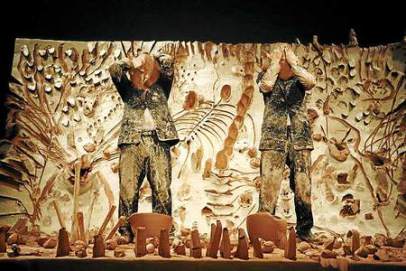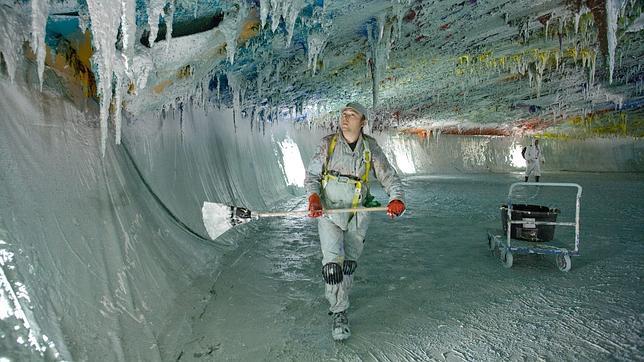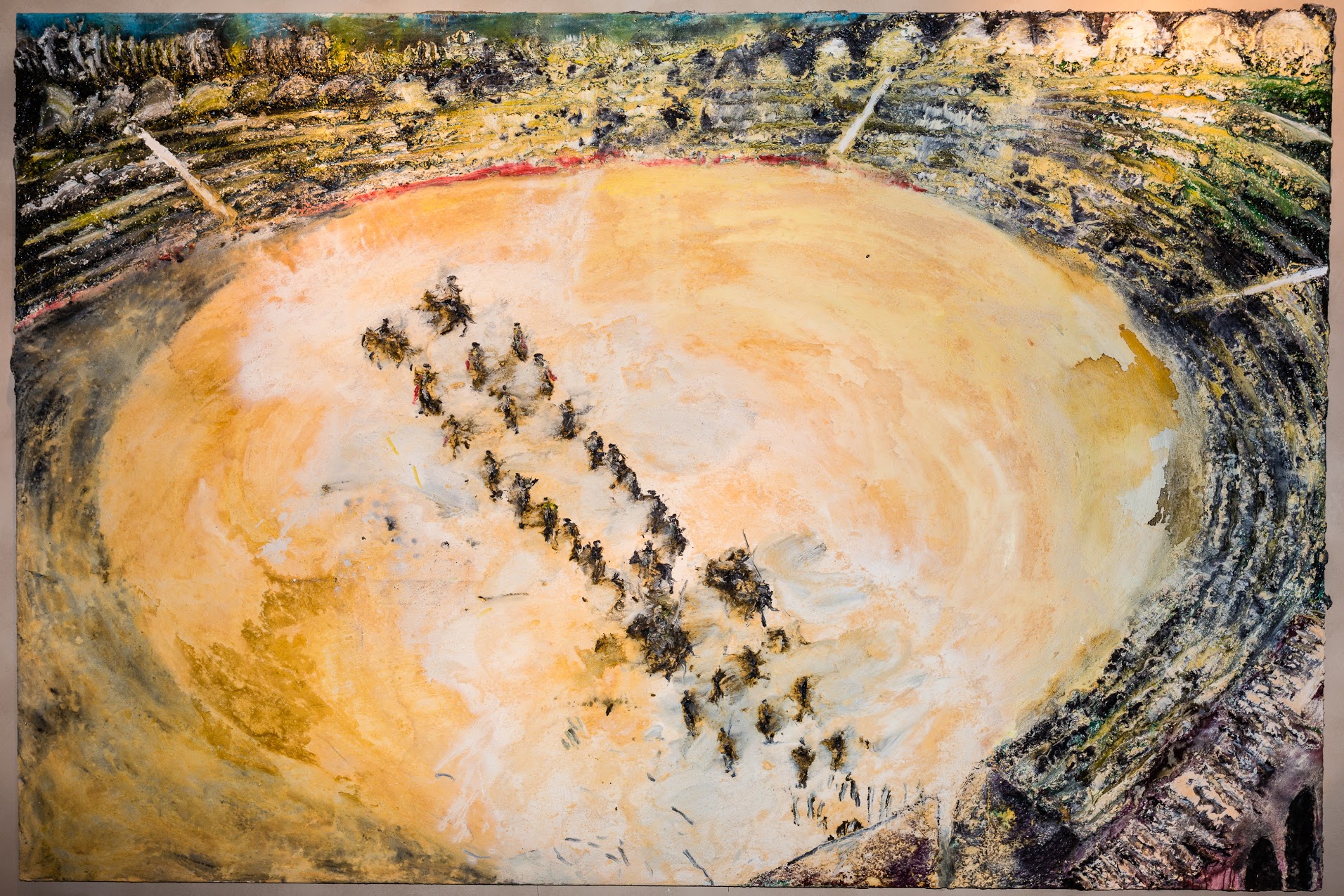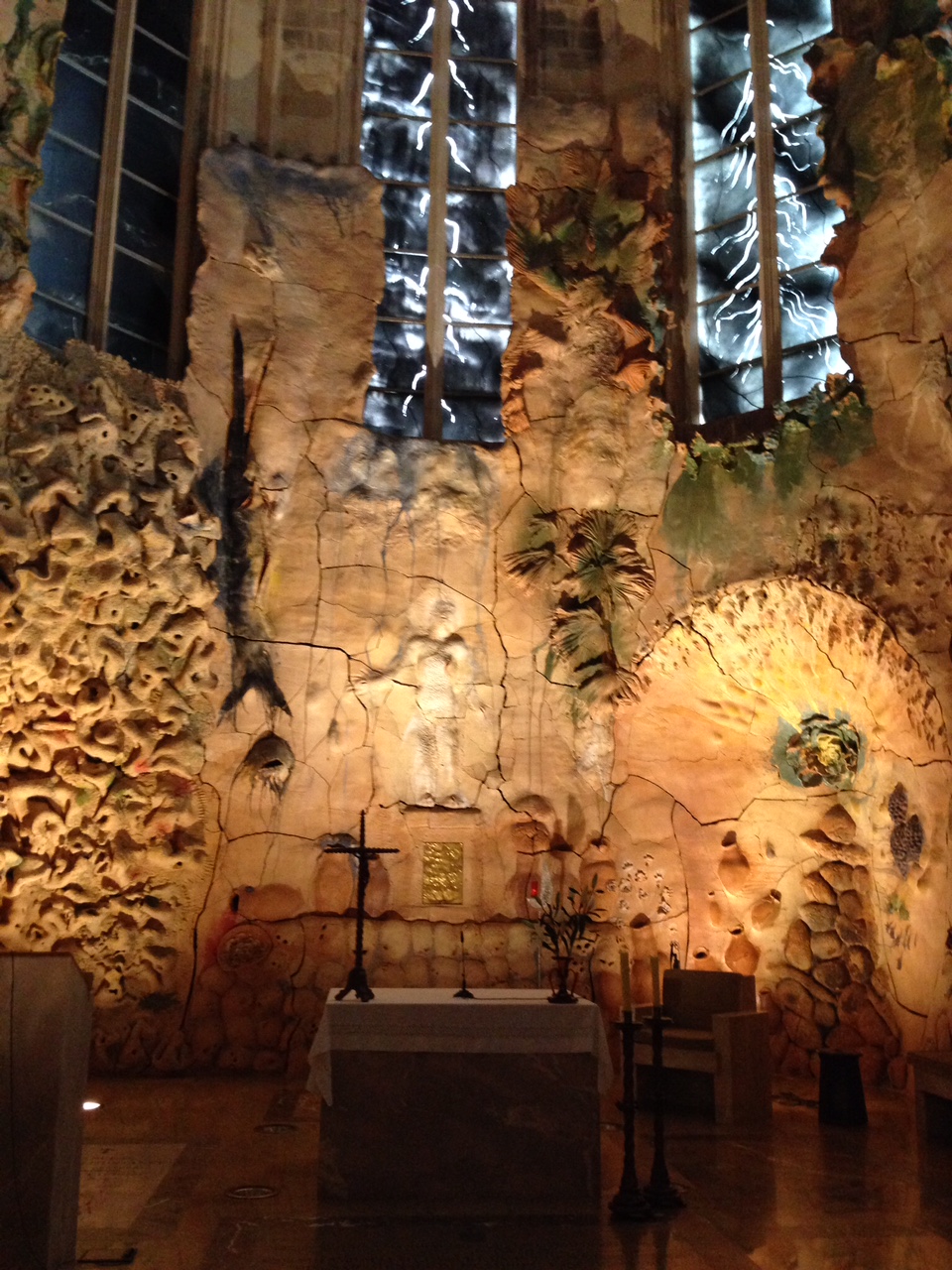Author: Elena Cué

Both the Island of Mallorca and circumstances have led me to a meeting with Miquel Barceló during which I had the opportunity to discover more about his life and work. The visit began in his ceramics workshop, La Taulera, and ended in his home and workshop in Farrutx.
“Have you seen these black pieces? They are smoky” the artist says while he shows me the study. “I leave them there in the chimney so the soot covers them and then we attach cobwebs and everything. I really like it. The clay I use is from just near here and it ends up being this bread-like colour, as you can see, which happens to be the colour of Mallorca cities”.
The workshop has a certain incline: “The soil went in through there and comes out in the shape of a tile or something. Claude Parent came up with a theory about oblique architecture that goes back to the 1960s, because obliqueness always forces you to be in action. If it is horizontal you’re stationary, if it’s oblique it’s dynamic. It’s fun to live in an oblique house because if something falls off the table it will roll away. It’s a very interesting philosophical concept”.
Elena Cué: Will this ceramic piece be black?
Miquel Barceló: I never know what they will become.
E.C: When did you begin creating black ceramics?
M.B: I started to create ceramics in Africa and black ceramics not so long ago. First I began making smoky paintings, because a way to destroy the work I throw away is by burning it. But given that ceramics can’t be burnt, we crush it to make grog, which is ceramic dust, and then we turn it into something else. Regarding the paintings, it’s strange because I wanted to destroy some by smoking them, but as I started to scratch them, they turned into something else. The same happens with ceramics; they turn into objects. Look at this black cut, it’s like firewood... I hate these bright and colourful ceramics. I like ceramics from two thousand years ago, the Andalusian ones. In fact, in general, there is very little I actually like about ceramics. I like some of Miró and Fontana’s work in ceramics, but I think contemporary ceramics are horrible.
E.C: I visited the Caves of Drach...
M.B: The Caves of Drach, the Cathedral of Mallorca and the bottom of the sea are definitely my favourite places here.
E.C: Have you seen the girl’s hand that was recently discovered?
M.B: Yes, things appear constantly. Here they analyse a coprolite and say, “it’s 50,000 years old”. It’s a race to see who has the oldest cave, it’s stupid. Altamira is wonderful but there is nothing even remotely similar to Chauvet. It’s an absolute jewel; the oldest and yet the best, it’s ironic.
E.C: I remember you said Chauvet was one of the most inspiring aesthetic experiences of your life.
M.B: The Chauvet cave has more to offer than Altamira, Lascaux, or any other. I have seen them all so many times, it’s almost a profession. There is something about this particular cave that goes beyond what we are able to understand. Yet in the Altarmira cave, we not only understand how it was built, but very much the reason why. Instead, in Chauvet, there is something that escapes us; a relationship between man and his paintings that we also cannot grasp, that sort of deep empathy with the animal. The difference in the animals’ morphology is amazing. In Lascaux, one bison is every bison; they even used a template, which is very modern. They had a piece of skin to draw the outline. When they paint a bison, it is a generic bison. On the other hand, in Chauvet a horse or a lioness is unique to the point that there will be no other exactly the same as it. So unique, you could even give it a name and surname. It’s like Rembrandt’s group painting, in which each character has a life and parents and children, it is amazing. Chauvet is the other example of a culture we know nothing about. And it is very likely that their epigones can be found in the caves of Altamira.
E.C: Why the obsession with caves?
M.B: There are many here; for me it’s like going under water. It’s also the place where light is made. The cave creates things, it’s always fascinating. It’s also the place for burials and reflection. Where I live there is a cave and this was a very determining factor when I decided to buy the house.
E.C: I can see your last paintings are not so matter-orientated.
M.B: I don’t like my work to be particularly matter-heavy. I mean I do really like Velázquez, and his work was like that, but it’s not so much because of the amount of matter used, but more about the perception. With Goya or Velázquez, it is not the amount of impasto but the evidence of the impasto that’s important in each brush-stroke, meaning it is not an abstraction, it’s a physical fact that makes the difference between Velázquez and Goya. That kind of physicality of things is very much what characterises Spanish painting. Even painters like Meléndez or other painters that seem flat. Rembrandt began painting like Meléndez did for his whole life, and then he gradually started refining and concentrating... Like Giacometti, he came to the conclusion that all human figures converge at the nose. It’s like a pyramid, they said his paintings could be hung from the nose because he used a lot of impasto on them, poor Rembrandt. And Meléndez was a frustrated figure painter, he always wanted to be a realist painter, a portrait painter, he was trained for that. He was the son of painters and he was trained to become a leading figure. But poor Melendez never managed to be a realist painter and he had to paint still life his whole life. There are hidden figures within the still life paintings which make each tomato like a portrait and its life begins on the edge of the table. All of his paintings stand out because of this edge, at the beginning they are clean and in the end he paints the bumps and scars he has suffered throughout his life, as if he was painting all his wounds.
E.C: Fascinating...
M.B: I have read a lot about the life of painters, I enjoy it. The only place where I always feel affinity with people is in the Museo del Prado. When looking at the paintings, I feel there are things we do share. I go there very often, whenever I can. It is my favourite museum. It’s the great painting museum. I also like the Museum of Cairo, it is wonderful, but El Prado is the best painting museum in the world. The Louvre Museum is a great global museum, but El Prado is the painting museum and baroque painting museum. It’s traditional and of a private culture.

E.C: There is another, more beautiful Africa, but you chose one of the poorest countries in the world, Mali (Dogon Country). Arid soil, full of dust, desert, termites, illness, death... Why?
M.B: I didn’t choose it, it chose me. First I was going to cross the desert, because I had been living in New York and I had been painting these white paintings and I did not quite know the reason why, a kind of need for cleanliness, to renovate something. I also wanted to get rid of the burdens I was carrying. So I went to the desert without really knowing exactly where I was going, a trip with Mariscal, so then we went to ask a guy who did the Paris Dakar for advice because I didn’t even have a driver’s license.
E.C: Pure adventure.
M.B: Just imagine how daring; off I went in a Land Rover I had just bought. I usually do things this way... They told me to be careful with the dust, which could even get into a can of sardines, and I thought it was sort of a metaphor, but it turned out it wasn’t. It was a fact, a reality. The dust got into everything; in between papers, in the paint... At the beginning I fought against it, like the termites, but in the end I incorporated it. It was like a gift, it improved everything. And my work had meaning there. We went to Gao, to Timbuktu, next to the river. It was a place of great beauty with a pink dune, which is a sand mountain where couples go to to see the sunset. So I started painting, not like in New York, Paris, or any other place. Painting a big painting on the floor didn’t have any meaning. I started drawing at the market, like when I was 12 years old; I started to draw people and sand. It’s like being in space, painting without gravity - like drawing nothingness. Spaces without a horizon are pure light. I started the sketchbook and the watercolours and then I got to the Dogon Country and I was fascinated. To begin with, I only knew its statuary because you can find it in museums. It didn’t even interest me that much until later on when I got to know it. Then, in 1991, the Dogons built me a house, but there was a coup and a revolution, so for a month I went across the Niger River in a canoe.
E.C: Was it dangerous?
M.B: Well, there were soldiers, armed Tuareg... The canoe was easy to spot, it was different from the rest, because I built it to paint on it. It had a table with sides. I painted the front and back of the small boat and we sold it there for 300 Euros, the normal price for a canoe. When I sold it, I wondered if there was some smart-arse who knew my work and maybe I would find it later in Paris. But it ended up in Gao, old, and I’m happy, it was good that no collector had found it. Anyway, later the Dogons built me another house in the best place, next to a water fountain and some caves, a fantastic place, which is still my house.

E.C: When listening to so many experiences one of your profound remarks comes to mind: “We paint because life is not enough. Regardless, life is enough here. It is almost excessive”. Did time slow down there and was life so cruel that it became excessive?
M.B: Everything is extreme in Gao; happiness is extreme and pain is extreme, boredom, everything is extreme. Everything is lived intensely. If you’re sick, you almost die, everything is intense. That is why you miss it so much later. But you are also spending such a long time just sat waiting because it is so hot. Sometimes it reaches 50 degrees, and you have to wait until the temperature cools down. By nature I’m not patient at all, but I think in Africa I learnt a lot about this kind of patience.
E.C: What did you do during the time you had to spend waiting?
M.B: I wrote, drew, I was able to read, think or do nothing. But I remember when the typical policemen would stop you and ask for money if you were a white person. At the beginning I bargained but then I learned the rules. I learned that if the policeman didn’t have weapons, or a cell phone, I’d wave at them and keep going. In Africa they are so polite that you say “Salam Aleikum” and they reply, and then they whistle at you to stop, but you are already a hundred meters away. So I decided- if they have a weapon I’ll stop; if they don’t I’ll keep walking.
E.C: Were you able to remain patient?
M.B: The first time I crossed a line that they had painted on the road behind a corner, I got out of the car with my friends, I got the teapot and mats out and I started making tea. They kicked us out immediately. When they see you’re not in a hurry, they kick you out. They know how to bargain with white people in a rush, which almost all of us are. White people tell them “I have a flight tomorrow” and they think great, I’ll get a lot here. The thing is we are transparent.
E.C: What do you miss most about Mali?
M.B: I think most of all I miss the laughter. Every single day I would be among friends and we would laugh so hard we would cry. Literally around fifty people, both men and women, used to come to my house and drink tea or beer and tell stories.
E.C: And what were those stories like?
M.B: They were their stories. They retell the same story they have told you fifty times before, but an improved version of it, it is about constantly making it better. I learnt this from Paul Bowles in Tangier, because he transcribed the stories from the market, from the illiterate storytellers. The stories were published in Anagrama.
E.C: Don’t you have his book collection?
M.B: Yes, I have his book collection. In his older years we became friends, he was 80 years old. He was the only European who had come to live in Africa at that time. For me, he was a role model; he was not the typical guy who goes to live in Bora Bora. Like me, who went to live in Dogon Country... Who decides to go and live there? A successful and wealthy guy goes to live in other places. Francesco Clemente went to the south of India, near Goa, he was more chic. Dogon Country was one of the poorest.
E.C: I thought it was more a search for purification?
M.B: I was not looking for that, I liked it so much that I stayed. I think I needed to find a balance.
E.C: Do you go to the extreme to find that balance?
M.B: Yes, I have a tendency to do that. But there I also found something no other place had, this Dogon wisdom and this way of being in harmony with things. Everything makes sense there, you never know if it has been made by man or by nature, it has a perfect harmony which is very hard to find. And I liked the relationship with people. The same happened with food, which is very sober and of an absolute simplicity. Mali’s food is very tough, there is only grain, it is like Neolithic food, but you get used to everything. I think it suited me well, because I was afraid of becoming a cretin and not realising it, seeing that I had reached success at a very young age. Cretins are the last ones to become aware. In art, it is easy to lose tension and my friends were dying during all these years, Basquiat and the painters from my generation.

E.C: You also have a lot of merit because you were involved...
M.B: In things that are not very healthy.
E.C: Yes, but there is more merit to sever ties with everything, friends included...
M.B: It was the 70s. And between one day and the next I think I realized I had this great power to walk away. In the past I didn’t know if I was going to be able to. I knew it when I did it. It is like the chapel of the cathedral, I found out I could do it by doing it. I think it is like that, you know things when you do them. Each painting is like that. So if you fail, nothing happens because you start again. Now that I think about it, when I was going to work in the Cathedral I didn’t know quite how I was going to do it. I knew I wanted to make a great cracked ceramic, divided naturally. I didn ́t want cut tiles, and somehow I had the need to do it, I had the confidence that I would do it.

E.C: This experience was similar to the Chapel of the United Nations, since it took you many months to find the appropriate material.
M.B: It was painful. From September to February. We had to throw everything away, and I had to fire a whole team.
E.C: And the French students?
M.B: I also had to fire them and I still don’t talk to anyone. One of them came to me with some sort of papier mache proposal, like a decoration. I told him: “No, I want to make a cave of painting, I do not want to decorate...” So I started again but it was very complicated and I was lucky they didn’t fire me. Working with the pressure of a contract which is about to expire and with penalty for delay. They reassured me, but the United Nations needed this hall.
E.C: Did they understand it?
M.B: One day I wanted to explain properly to “the ones in charge” (I don’t want to mention names), what was going on. So I used an inappropriate metaphor related to suicide and said, for instance: “Look, for someone like my grandfather suicide was not an option; it was forbidden by the Church, by his philosophy, it was anything else but that”. For me and for our generation since Nietzsche, suicide was an option. For an artist failure is an option, that is, I never have the guarantee that a work will succeed, because if I had it I would never do it. Today you have seen the shattered pieces in the workshop. Each of them was an entire day of work and that was a failure, and this other was a technical failure, because of humidity. So, whoever told it, made a summary about the suicide thing. Perhaps he thought there was a risk of me committing suicide and told me: “No, calm down, take as much time as you want”. He thought I was going to hang myself from a stalactite, it was very funny.

E.C: Art: how much is pleasure and how much anguish?
M.B: Anguish is a work tool, it goes with my work. Anguish is like another brush, it is implicit. I don’t find a way to avoid it, sometimes you go beyond it. And also there is great pleasure, of course. The evil grace is that you’re never able to repeat the same pattern. Sometimes it turns out very well, and I go back to my workshop wondering if I step on the same stones, if I do exactly the same thing, it will turn out fine. No. Never.
E.C: Why?
M.B: It is a miracle that can never be repeated in the same way. Paradoxically, it will be repeated in another way, the complete opposite. It is about accepting, about accepting right and wrong just as it comes. The banalities that are always spoken are true.
E.C: Mali, Nepal, Japan, Sicily, Paris... You are a cosmopolitan man, some kind of migrant in a strange land. Why the need for a nomadic life?
M.B: It must be a result of the isolation. I understood that the first time I lived surrounded by water, I became claustrophobic. I have always seen the ships and wanted to be inside, even though painters are very sedentary.
E.C: Also as a source of inspiration?
M.B: Yes, after Mali I needed something at this level. That is why I went to the Himalayas, because I thought there was something there with a similar spiritual level to Mali, something I had not seen elsewhere. I went across the mountain range and I’m going back this summer. Also because I like the summer less here and I like August there. I have always thought that painters should constantly invent the techniques and the tools, we don’t have to assume anything. We have to reconsider it. In the Himalayas you have to reinvent how to work. Last time, I was working with parchments and I took some from here with me. I was working with them in monasteries. It is funny because the monks told me I was responsible for the animal, because each parchment was the skin of an animal. It is not a sin, you are responsible. It is nice: I had a little flock with me. Now I think about that with any piece of fabric, that you have to be responsible. It is a responsibility to place something new in the world; it does not matter if it is just a pot.
E.C: Mali’s situation is sad...
M.B: Mali has left a mark on me forever, without a doubt; in my work and in myself. But I already knew it was going to end badly, because I saw it coming. Even though I didn’t think it was going to end up quite so badly... Well, I thought my children would keep on going because they had a lot of friends there. Hopefully this will continue for them too. They meet there to make collective works. Since I no longer take part in these activities, I try to help with other things. It is fine if my children inherit this responsibility to try and improve, but these are things one cannot speak of. You do them but then don’t talk about them.

E.C: I’m curious to know what happens inside the artist at the beginning of the creative process. The transformation from impulse to sublimation. You have mentioned that your painting is an activity that is, to some extent, sexual.
M.B: Yes, yes, everything is very sexual. It is clear. When I see the ceramics, it is so evident to me that sometimes it was almost ridiculous for me to emphasise it. Like in these vases of female genitals. In Palma Cathedral I looked at it with a psychoanalyst who is a friend of mine and I explained to her how some fish are like male genitals, and the fish open like vaginas and anuses. Our view of the world is a lot like this.



